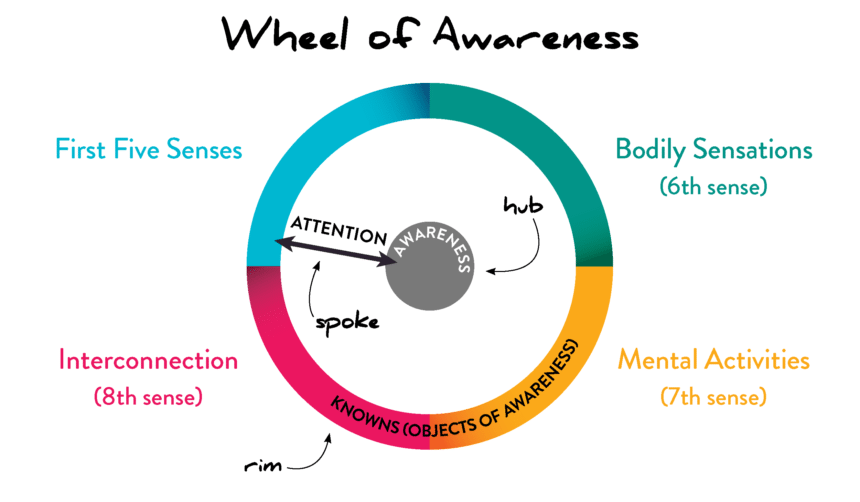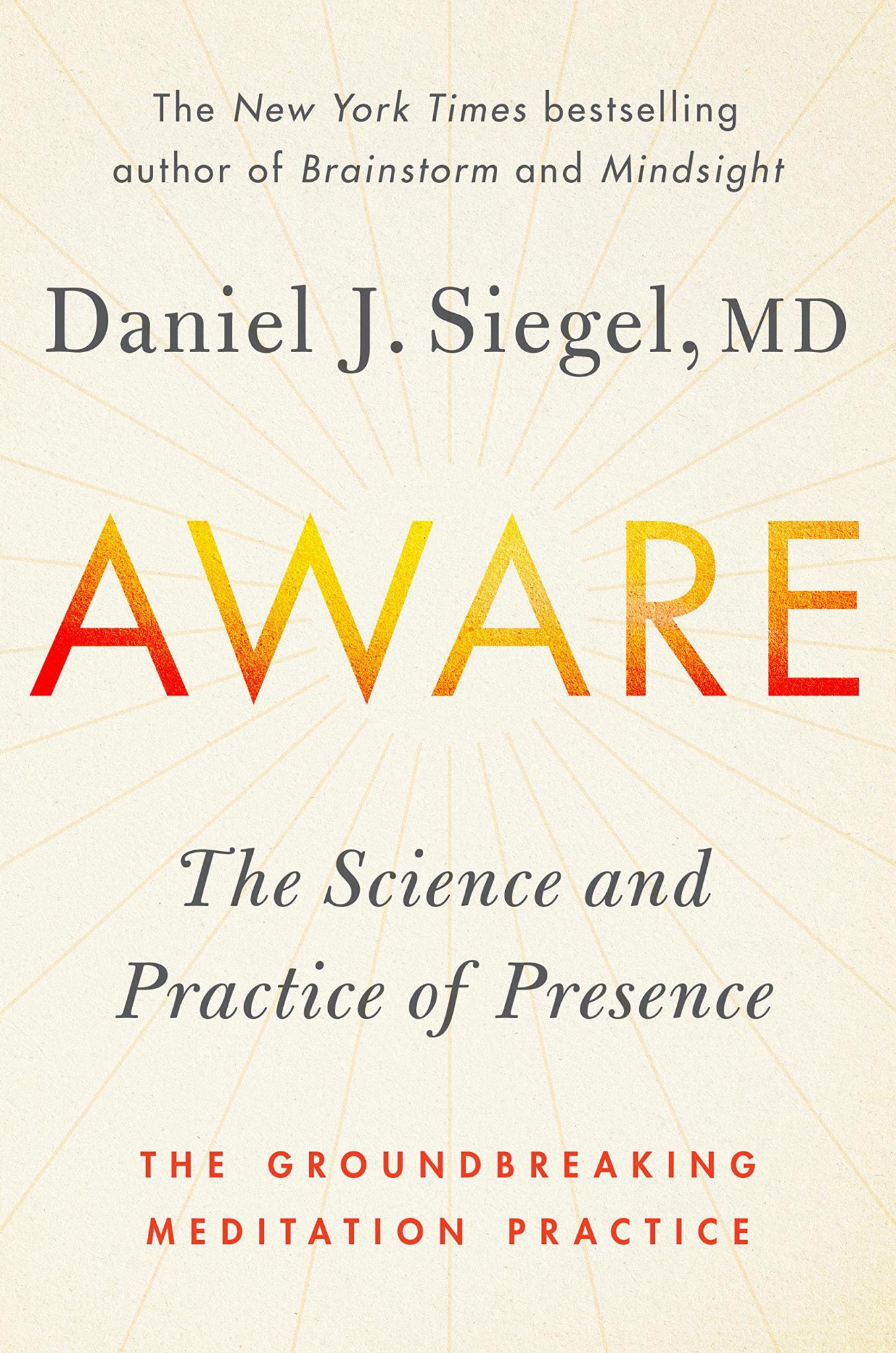The Wheel of Awareness
By Daniel J. Siegel, M.D.The Wheel of Awareness is a useful tool I’ve developed over many years to help expand the container of consciousness.
I’ve offered the Wheel to thousands of individuals around the world, and it’s proven to be a practice that can help people develop more well-being in both their inner and interpersonal lives. The Wheel of Awareness practice is based on simple steps that are easy to learn and then apply in your everyday experiences.
The Wheel of Awareness is very useful as a visual metaphor for the way the mind works. The concept came to me one day as I stood looking down at a circular table in my office. The tabletop consists of a clear glass center surrounded by a wooden outer rim. It occurred to me that our awareness could be seen as lying at the center of a circle—a hub, if you will—form which, at any given moment, we can choose to focus on a wide array of thoughts, feelings, and sensations circling us on the rim. In other words, what we could be aware of could be represented on the wooden rim; the experience of being aware we could place in the hub.
If I teach people how to expand that container of consciousness by more freely and fully accessing the Wheel’s hub of awareness, they’d be able to change the way they experienced life’s tablespoons of salt, and perhaps even learn to savor life’s sweetness in a more balanced and fulfilling way, even if there were a lot of salt present at the time. As I looked down at this table, I saw that the clarity of that glass hub might represent how we became aware of all of these tablespoons of life, each of the varied experiences we could become aware of, from thoughts to sensations, which we might now visualize as being placed on the circle around this hub—the table’s outer wooden rim.
 The central hub of that table, of what we were now calling the Wheel of Awareness, represents the experience of being aware, of knowing that one is surveying the knowns of life. The rim came to represent that which is known; for instance, at this moment, you are aware of the words you are reading on this page, and now perhaps you’ve become aware of the associations you are having with the words—for example, the images or memories that come to mind.
The central hub of that table, of what we were now calling the Wheel of Awareness, represents the experience of being aware, of knowing that one is surveying the knowns of life. The rim came to represent that which is known; for instance, at this moment, you are aware of the words you are reading on this page, and now perhaps you’ve become aware of the associations you are having with the words—for example, the images or memories that come to mind.
Consciousness can be simply defined as our subjective sense of knowing—like your awareness now of my writing the word hello. “You knowing” is awareness; “hello” is the known. The knowing is in the hub; the knowns are on the rim. When we speak of expanding the container of consciousness, we are then strengthening the experience of knowing—strengthening and opening our capacity to be aware.
Now imagine what might happen if, from the starting point of the hub, our attention were directed out to any of the various knowns on the rim, focused on one point or another—on a given thought, a perception, or a feeling; any single one of the wide range of the knowns of life that rest on the rim of the wheel. Extending the metaphor of the wheel, one might envision these moments of focusing attention as a spoke on the wheel.
The spoke of attention connects the hub of knowing to the rim of the knowns.
In the practice, I’d have my patients or students get centered and imagine the minds to be like the Wheel of Awareness. We’d envision next how the rim could be divided into four parts or segments, each of which contains a certain category of knowns. The first segment contains the category of knowns of our first five senses: hearing, sight, smell, taste, and touch; the second segment represents another category of knowns, one that includes the interior signals of the body, such as sensations from the mental activities of feelings, thoughts, and memories, while the fourth holds our sense of connection to other people and to nature, our relational sense.
We’d slowly move that singular spoke of attention around the rim, bringing into focus, one by one, each of the elements of that segment, and then move the spoke of attention to the next segment, and review those points as well. Systematically we’d be taking in rim element by rim element, moving the spoke of attention around the rim of knowns. As the practice unfolded in a given session, and as individuals would continue to practice on a regular basis, there was a common description of feeling more clarity and calm, a deeper sense of stability and even vitality, not just during the practice itself, but during the rest of the day.
 The Wheel of Awareness practice became a way to open awareness and cultivate a larger, more expansive container of consciousness. People who participated in the practice seemed to be strengthening their minds.
The Wheel of Awareness practice became a way to open awareness and cultivate a larger, more expansive container of consciousness. People who participated in the practice seemed to be strengthening their minds.
The Wheel was designed as a practice that could balance our lives by integrating the experience of consciousness. How? By distinguishing the wide array of knowns on the rim from each other and from the knowing of awareness in the hub itself, we could differentiate the components of consciousness. Then, by systematically connecting these knowns of the rim to the knowing of the hub with the movement of the spoke of attention, it became possible to link the differentiated parts of consciousness. This is how by differentiating and linking, the Wheel of Awareness practice integrates consciousness.
One of the fundamental emergent properties of complex systems in this reality of ours is called self-organization. That’s a term you might think someone in psychology or even business might have created—but it is a mathematical term. The form or shape of the unfolding of a complex system is determined by this emergent property of self-organization. This unfolding can be optimized, or it can be constrained. When it’s not optimizing, it moves toward chaos or toward rigidity. When it is optimizing, it moves toward harmony and flexibility.
Given the experience of the chaos and rigidity I had been observing in my patients (and my friends and myself when things weren’t going well), I began to wonder if the mind might be some kind of self-organizing process. A strong mind might be optimizing self-organization and create an experience of harmony in life; a compromised mind might lean away from that harmony and toward chaos or rigidity. If this were true, then cultivating a strong mind might be aided by asking how optimal self-organization occurs. There is an answer to the question.
The linking of differentiated parts of a complex system is how the emergent self-organizing property that regulates how that system unfolds over time—how it self-organizes—moves toward optimal functioning. In other words, integration (as we are defining it with the balancing of differentiation and linkage) creates optimal self-organization.
The essential idea behind the Wheel of Awareness was to expand the container of consciousness and, in effect, balance the experience of consciousness itself. Balance is a common term that we can understand scientifically as coming from a process that can be called integration—the allowing of things to be different or distinct from each other on the other. When we differentiate and link, we integrate. We become balanced and coordinated in life when we create integration. Various scientific disciplines may use other terminology, but the concept is the same. Integration—the balancing of differentiation and linkages—is the basis for optimal regulation that enables us to flow between chaos and rigidity, the core process that helps us flourish and thrive. Health comes from integration. It’s that simple, and that important.
A system that is integrated is in a flow of harmony. Just as in a choir, with each singer’s voice both differentiated from the other singers’ voices but also linked, harmony emerges with integration. What is important to note that this linkage does not remove the differences, as in the notion of blending; instead it maintains these unique contributions as it links them together. Integration is more like a fruit salad than a smoothie. This is how integration creates the synergy of the whole being greater than the sum of its parts. Likewise, this synergy of integration means that the many aspects of our lives, like the many points on the rim, can each be honored for their differences but then brought together in harmony.
Many individuals have found the Wheel of Awareness a skill-building practice that empowers them in quite profound ways. It transformed how they came to experience their inner, mental lives—their emotions, thoughts, and memories—opened new ways of intersecting with others, and even expanded a sense of connection and meaning in their lives.
Adapted from Aware: The Science and Practice of Presence, published by TarcherPerigee, Copyright © 2018 by Daniel J. Siegel, M.D.
Dr. Dan Siegel is a clinical professor of psychiatry at the UCLA School of Medicine and the founding co-director of the Mindful Awareness Research Center at UCLA. He is also the Executive Director of the Mindsight Institute, which focuses on how the development of mindsight in individuals, families, and communities can be enhanced by examining the interface of human relationships and basic biological processes. He is the author of many books, including, his upcoming book, Aware: The Science and Practice of Presence.
Please join Dr. Dan Siegel on October 4, 2018 at 7pm at the Marlene Meyerson JCC Manhattan for a special event to launch his new book, Aware: The Science and Practice of Presence. To register, please click here.
Photo by Garidy Sanders on Unsplash

Panic attacks are real from trauma. At night you want to quite your mind. People who need this type of therapy something is seriously unbalanced. The Chinese believe in Young and Yang. If the world was more positive people would be healthier and happier. Drugs, Alcohol, Power, money. As a Christian when we pray we are in a form of mediating with him. Lying down a half a hour each day, closing you eyes and thinking of a wonderful place, control your breathing, relax your whole body, feel a sense of peace. Science is best guess. Jesus, the father is hope for better tomorrow. I did see him looking any younger on Dr. Phil. When you sleep clear your mind and rest leave the hectic day behind all the pain and worries.